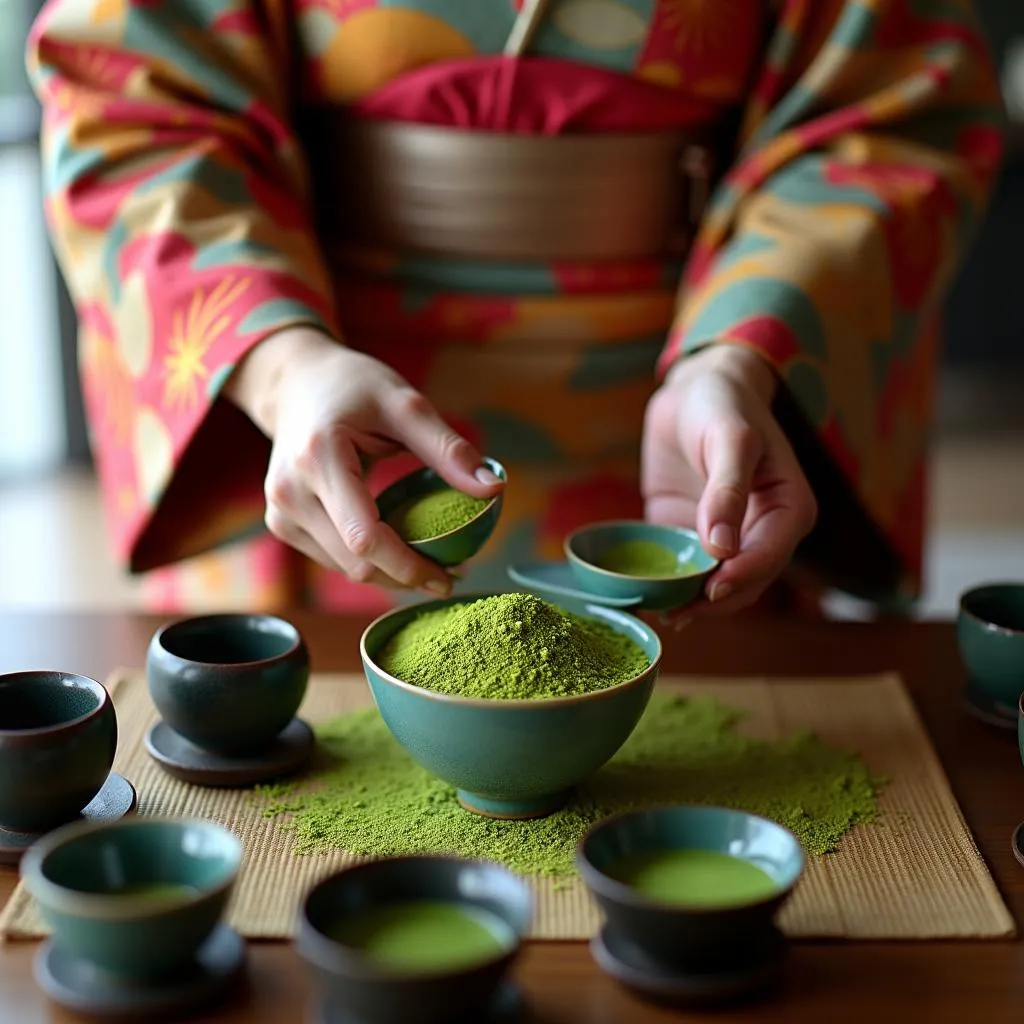Japan, a land of contrasts where ancient traditions meet modern marvels, offers a unique and exquisite afternoon tea experience that goes beyond the ordinary. More than just a beverage, Japanese afternoon tea, or kissa, is a cultural immersion that tantalizes the senses and offers a glimpse into the heart of Japanese aesthetics and hospitality.
 Traditional Japanese Tea Ceremony
Traditional Japanese Tea Ceremony
Indulge in the Art of Japanese Tea Ceremony
At the heart of the Japanese afternoon tea experience lies the captivating ritual of the tea ceremony, known as Chanoyu or Sado. This centuries-old tradition is a mesmerizing performance of grace, precision, and mindfulness. Witnessing a tea master meticulously prepare and serve matcha, a finely ground green tea, is an experience that transcends mere consumption and becomes an art form in itself. Every movement, from the whisking of the matcha to the presentation of the tea bowl, is imbued with symbolism and respect, creating an atmosphere of tranquility and reverence.
Savor the Delicate Flavors of Wagashi
No Japanese afternoon tea is complete without wagashi, traditional Japanese sweets crafted to complement the delicate bitterness of matcha. These miniature works of art are as pleasing to the eye as they are to the palate. From mochi, soft and chewy rice cakes, to delicate jelly-like confections and seasonal bean paste sweets, wagashi offers a delightful journey of textures and flavors. Each piece is often crafted to reflect the beauty of nature, with intricate designs inspired by flowers, leaves, or landscapes.
 Colorful Wagashi Selection
Colorful Wagashi Selection
Find Your Zen in Serene Tea Rooms
Escape the bustling city streets and step into a world of tranquility in one of Japan’s enchanting tea rooms. Many tea houses are designed in traditional Japanese architectural styles, offering a serene and minimalist ambiance that invites reflection and relaxation. From hidden gardens to tatami-floored rooms overlooking peaceful ponds, these spaces provide the perfect setting to unwind and savor the moment.
Experience the Diversity of Afternoon Tea in Japan
While traditional tea ceremonies offer a deeply cultural experience, Japan also embraces modern interpretations of afternoon tea. Luxury hotels and cafes across the country present their own unique takes, often incorporating Western influences like scones and finger sandwiches alongside Japanese elements.
Plan Your Perfect Afternoon Tea Tour
Ready to embark on a journey of flavor and culture? Whether you seek the authenticity of a traditional tea ceremony or the modern elegance of a hotel afternoon tea, Japan offers something for every taste and preference. Here are a few tips to help you plan your perfect Afternoon Tea Tour:
- Research and book in advance: Popular tea houses and experiences often require reservations, especially during peak seasons.
- Dress respectfully: While not always mandatory, dressing smartly shows respect for the tradition and ambiance of the tea room.
- Embrace the moment: Allow yourself to be fully present and appreciate the artistry, flavors, and cultural nuances of the experience.
- Don’t hesitate to ask questions: Your hosts are often knowledgeable and passionate about sharing their culture, so feel free to inquire about the teas, sweets, or traditions.
 Elegant Japanese Tea Room
Elegant Japanese Tea Room
Conclusion
An afternoon tea tour in Japan is more than just a culinary experience; it’s a journey into the heart of Japanese culture. From the meticulous rituals of the tea ceremony to the delicate artistry of wagashi and the serene beauty of traditional tea rooms, this is an experience that will captivate your senses and leave you with lasting memories. So, why wait? Begin planning your unforgettable Japanese afternoon tea adventure today!
Frequently Asked Questions
1. What is the best time of year to experience afternoon tea in Japan?
Japan offers unique seasonal delights throughout the year, but spring and autumn are particularly special for afternoon tea. Spring brings cherry blossom-themed treats, while autumn offers vibrant colors and flavors of fall.
2. Is it necessary to know Japanese to enjoy a traditional tea ceremony?
While knowing some basic Japanese phrases can enhance your experience, many tea houses cater to international visitors and provide English explanations or guides.
3. What are some recommended places to experience afternoon tea in Tokyo?
Tokyo offers a wealth of options, from traditional tea houses in historical districts like Asakusa and Yanaka to luxurious hotels with stunning city views.
4. Are there vegetarian or vegan options available for afternoon tea in Japan?
While traditional wagashi often contains dairy or gelatin, many establishments now offer vegan and vegetarian-friendly options upon request. It’s best to inquire in advance.
5. What is the appropriate etiquette for a Japanese tea ceremony?
Traditional tea ceremonies have specific customs and etiquette, such as bowing upon entering the tea room, handling the tea bowl with respect, and expressing gratitude to the host. Your guide or tea master will typically explain these customs.
Have more questions about planning your perfect afternoon tea tour in Japan? Don’t hesitate to reach out! We’re here to help you every step of the way. Contact us at Phone Number: 0373298888, Email: [email protected] or visit us at 86 Cầu Giấy, Hà Nội. Our 24/7 customer service team is always ready to assist you.